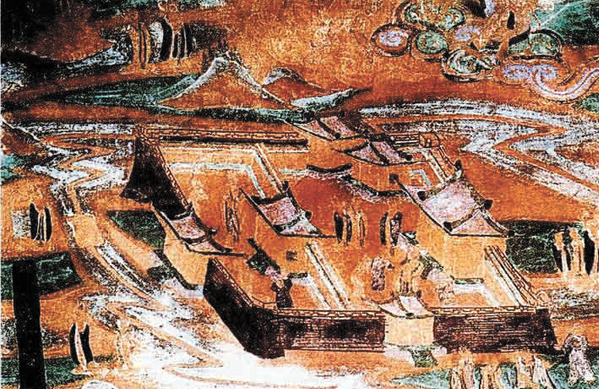Khotan myths reflect local historical development

This piece of Dunhuang murals shows the capital city of the Kingdom of Khotan, which, according to Khotan myths, was established by an Oriental prince.
Khotan, the ancient Buddhist culture located in the modern day Xinjiang Autonomous Region, has always been a place filled with myths and legends. The Great Tang Records on the Western Regions, Records of Khotan or Li-yul Lung-bstan-pa in Tibetan, and other documents recorded a number of myths about Khotan. Many of these myths are related to local religious beliefs in Khotan. It is inevitable that some stories are mixed with farfetched tales, historical romances and outright fiction. But after lifting the mysterious veil of legends and romance to discover the historical truth behind them, scholars find the stories about the origins of Khotan civilization are just vivid descriptions of interactions and various cultures, religions, people and languages. So Khotan myths have a solid basis in history.
According to the legend of the Kingdom of Khotan, an Oriental prince defeated the original ruler in Khotan and acceded to the throne. This Oriental prince became the King of Khotan, but he didn’t have any offspring even in his old age. So he went to Vaisravana, the patron saint of Khotan, to pray for children. He cut a baby from the forehead of the statue of Vaisravana, but this baby didn’t consume human breast milk, so the worried king returned to the temple of Vaisravana. Accidently, the land in front of the temple was raised up, and it seemed to be in the shape of the woman’s breast. After that, the baby was fed by the “milk of the land breast” and finally grew up. Because this heir to the throne was fed by the land breast, the land breast, or Gostana in Sanskrit, became the title of his reign. That explains why Xuanzang (602-64), a Chinese Buddhist monk and writer of The Great Tang Records on the Western Regions, insisted on translating the Kingdom of Khotan as the Kingdom of Gostana, which is based on this legend and the influence from Sanskrit culture.
The legend of the Silk Princess tells the story of how silk textiles were introduced to Khotan. The King of Khotan heard that an Oriental country knew how to plant mulberries and raise silkworms, but this country kept these secrets and guarded them from those who sought to steal their techniques. So a clever idea occurred to the king. He decided to marry the princess of this Oriental country and told the princess that Khotan didn’t have silk or silkworm eggs and she could bring some with her to make silk clothes. The princess smuggled silkworm eggs out of her country by hiding them in her hat. Silk textile production was thus finally introduced to Khotan. Some scholars indicated that the Oriental country could be Khotan’s neighbor, the Loulan Kingdom.
Zhang Chunhai is a reporter at the Chinese Social Sciences Today.
